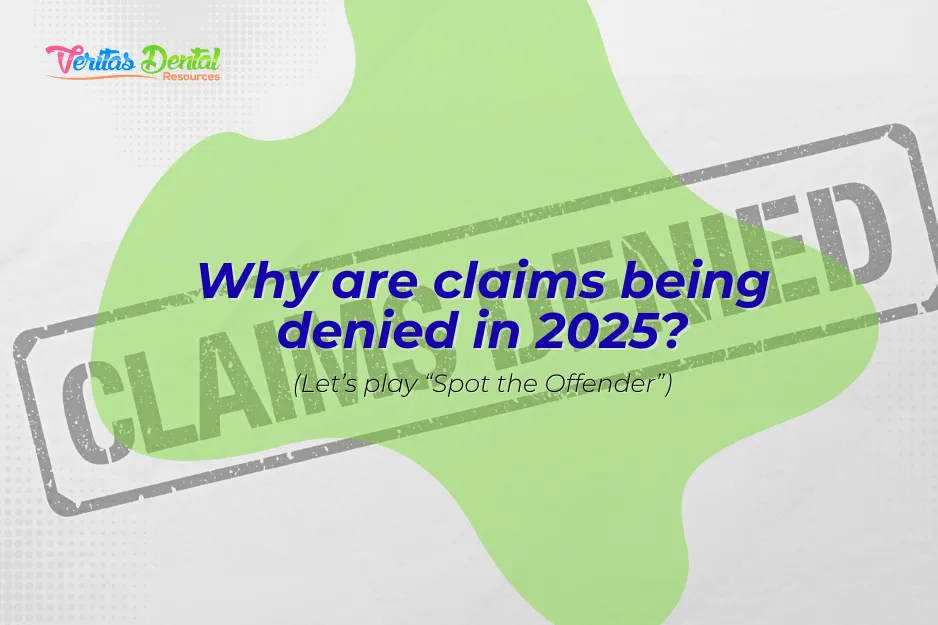
Why are claims being denied in 2025? (Let’s play “Spot the Offender”)
Claim denials don’t happen by magic
They reflect rules, oversight, and human or systemic error. In 2025, several trends make denials harder to escape than ever.
Top causes of denial (with a twist)
Missing or incorrect patient or insurance data
A misspelled name, wrong date of birth, outdated insurance ID—even one character off—can kill a claim.
Some carriers now run stricter eligibility audits at claim adjudication, so what used to “slip through” gets caught.
Insufficient documentation or missing attachments
Lack of X-rays, narratives, intraoral photos, or treatment planning documentation can prompt denials.
Some carriers insist on very specific documentation (like chart notes showing probing depths, bone loss, justification for crowns or implants).
Incorrect or outdated CDT coding or coding mismatches
Using deprecated codes, or codes that don’t align with documentation, or failing to use correct modifiers.
Some payers are increasingly automated and will flag or reject unusual code combinations.
Lack of prior authorization or missing pre-approval
Procedures that require pre-authorizations but are submitted without them are common pitfalls.
In 2025, many carriers are expanding their pre-authorization lists or applying stricter rules on those that already exist.
Non-covered services or plan exclusions
The infamous missing tooth clause (prosthetic work on a tooth missing before the plan’s effective date) still catches many.
Plan limitations like frequency limits on cleanings, waiting periods for major services, and annual caps can also hit hard.
Timely filing or claim deadlines
If your claim arrives a day late, it may be denied as non-timely.
Some payers are tightening their deadlines or enforcing them more strictly.
Automation and stricter payer audits
Payers increasingly use AI and automated rules engines to screen claims for risk patterns.
The fewer human forgiveness layers, the more critical your front-end rigor becomes.
Staffing or training gaps and policy churn
High turnover or outdated training leaves practices exposed.
Frequent mid-year policy changes or vague payer communications can trigger unintentional errors.
The cost of denial drag
Denials aren’t just annoying—they drain time, cash flow, and morale.
Every denied claim means rework, follow-up, resubmission, or appeals. Some reports say 60–65% of denied claims never get resubmitted, which means that money is gone for good.
Each denial costs staff hours, delays payments, and raises stress. If denial rates keep rising, offices that don’t adapt will feel the squeeze.
The goal isn’t just “deny less,” it’s “fail safe from the start and recover fast when denials happen.”
Denial-fighting playbook: 2025 Edition
Clean-Claim Culture
Verify eligibility before every appointment, ideally in real-time.
Make a “Claim Submission Checklist” for required attachments, documentation, and codes.
Track pre-authorizations carefully.
Train billing and clinical staff regularly and log denials to find patterns.
Use claim scrubbing tools or predictive analytics to catch risky claims before submission.
Stay on top of payer policy changes through bulletins or newsletters.
Swift action when a claim is denied
Sort denials fast—resubmit, appeal, or write off.
Set deadlines to work denials within five days or less.
Use templated appeal letters but personalize them.
Track which payers overturn denials and which codes succeed in appeals.
Escalate strategically when necessary, and don’t waste time on unwinnable cases.
Smarter staffing and process design
Assign a denial or appeal champion.
Cross-train billing and clinical teams.
Share denial trends so everyone sees where documentation or coding is slipping.
Streamline bottlenecks and consider outsourcing appeals if your bandwidth is low.
Technology & future trends
AI tools are both the problem and the solution. Many payers use automation to deny faster, but practices can use similar tech to catch errors first.
Analytics dashboards, interoperability, and predictive modeling can help you identify red flags early.
Some platforms even use AI to help draft appeal letters and organize documentation.
Real-world wins: try this next week
Pull your denial log for the last 60 days and find your top three reasons.
Hold a short “Denial Huddle” with your team to figure out what went wrong.
Challenge your office to “Clean Claim Days” where every claim must pass review before submission.
Ask your software vendor if they offer predictive denial tools—if not, push for it.
Track your appeal success with your most difficult payer for three months and act on what you find.
Final thoughts
Insurance denials will never be fun, but they don’t have to wreck your day.
The difference between constant chaos and a steady cash flow is usually process discipline and smart use of tech.
Drop your denial rate by even 10%, and you’ll feel the difference in your stress level and your bank balance.
If your team treats denials as fixable puzzles instead of failures, everyone wins.
Benjamin Tuinei
Founder – Veritas Dental Resources, LLC
📞 888-808-4513
Services: PPO Fee Negotiators, PPO Fee Negotiating, Insurance Fee Negotiating, Insurance Credentialing, Insurance Verifications
Websites: www.VeritasDentalResources.com, www.VerusDental.com

